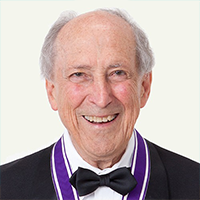Robert H. Dennard
Robert Dennard is an American electrical engineer and inventor. Dennard was born in Terrell, Texas, U.S.. He received his B.S. and M.S. degrees in Electrical Engineering from Southern Methodist University, Dallas, in 1954 and 1956, respectively.
Robert H. Dennard, in full Robert Heath Dennard, an American engineer credited with the invention of the one-transistor cell for dynamic random-access memory (DRAM) and with pioneering the set of consistent scaling principles that underlie the improved performance of increasingly miniaturized integrated circuits, two pivotal innovations that helped spur more than three decades of growth in the computer industry.
Dennard was born in Terrell, Texas, U.S.. He received his B.S. and M.S. degrees in Electrical Engineering from Southern Methodist University, Dallas, in 1954 and 1956, respectively. He earned a Ph.D. from Carnegie Institute of Technology in Pittsburgh, Pennsylvania, in 1958.
He joined the International Business Machines Corporation (IBM) in 1958 as a staff engineer and first worked on memory and logic circuits and on the development of data communication techniques. In the early 1960s he began focusing on microelectronics. His design for one-transistor-cell DRAM improved upon other types of computer memory that were then in development (including a memory system consisting of wire mesh and magnetic rings), and in 1968 Dennard was granted a patent for the design. It was one of more than four dozen patents that he was eventually issued. Dennard was given the title of IBM fellow in 1979, and he held several positions over the length of his career of more than 50 years with the company.
DRAM consists of an array of semiconductor memory cells that are integrated on a silicon chip. The type of memory cell invented by Dennard in the 1960s used a single metal-oxide-semiconductor (MOS) transistor to store and read binary data as an electrical charge on a MOS capacitor, and the high-density memory made possible by that design resulted in relatively low production costs and power requirements for DRAM. Following its introduction as a commercial product in the 1970s, one-transistor-cell DRAM was extensively used in computers and other electronic devices. With miniaturization, it was possible to develop DRAM chips that contain billions of memory cells.
Dennard was awarded the U.S. National Medal of Technology and Innovation, which he received (1988) from U.S. Pres. Ronald Reagan, and the 2005 Lemelson-MIT (Massachusetts Institute of Technology) Lifetime Achievement Award. In 2009 he received both the Medal of Honor from the Institute of Electrical and Electronics Engineers and the National Academy of Engineering’s Charles Stark Draper Prize. He later was awarded the Kyoto Prize (2013).

Robert H. Dennard
Date of Birth: 05 Sep 2021
Birth Place: Terrell, Texas, United States
Proffession: American electrical engineer
Nationality: United States


